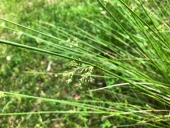Welcome to permies Leanna

I'm familiar with the theory, but not the practice of dealing with waterlogged areas, so anything I say is not based on personal experience!
These ideas describe a pretty labour-intensive, but relatively permanent solution...
I've seen boggy areas dramatically dried by digging out extra-low-lying spots on contour for ponds and proper wetlands, so that water is concentrated rather than the whole place being a bit of a bog.
There's a reasonable land % 'sacrificed', but short of building up the entire area...
Also, can you grow watercress there? There's lots of valuable crops that
need a swamp to grow.
There's amazing scope for encouraging all sorts of wildlife, and if mosquitoes are a problem, frogs, fish and ducks are multi-purpose solutions

Aside from the rushes, do you have access to chipped trees from the local council? I'd start dumping
loads of carbon onto the 'dry' spots to build up organic matter and aerobic microorganisms.
Boggy areas are generally anaerobic and very acidic. Have you had a soil test?It would be really interesting to see what happened as changes were made.
Your soil is probably acidic, and is quite possibly very low in phosphorus. Can you get
dry wood ash? I'd be mixing a bit of that in with my organic matter if the test says both levels are low







